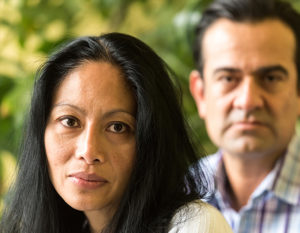Based on: Couple and family therapy for substance use disorders: Evidence-based update 2010-2019 Aaron Hogue, PhD, Jeremiah A. Schumm, PhD, Alexandra MacLean, MA, and Molly Bobek, MSW | January 2022 Journal of Marital and Family Therapy
Substance use disorders (SUDs) occur when an individual continues to use alcohol or other drugs despite experiencing problems related to their use (American Psychiatric Association, 2013). SUDs can contribute to a variety of couple- and family-related problems. These problems can in turn contribute to SUDs. Fortunately, there are couple- and family-based interventions for adults and adolescents with SUDs. We reviewed the past decade of research to provide an up-to-date picture of effective couple and family treatment for SUDs.
In a prior review, behavioral couples therapy (BCT) and community reinforcement and family training (CRAFT) was found to improve functioning and treatment engagement, respectively (O’Farrell & Clements, 2012). BCT has two main components. The first is interventions to build support for abstinence. This can be accomplished by helping the client’s partner learn skills for managing alcohol-related situations. Another strategy is to use a couple recovery contract to support abstinence. The second is relationship-focused interventions. These include strategies to increase positive behaviors between partners and promote shared mutually enjoyable activities. Couples also learn communication skills to improve the relationship. Unlike BCT, where the person with the SUD and a partner participate, CRAFT is made for concerned significant others (CSOs) of individuals with SUDs who are not ready to get help. CRAFT teaches CSOs communication skills to improve chances that their loved one agrees to enter treatment. It also teaches CSOs self-care and reconnection with their own values to improve their own lives. In examining the evidence for family-based interventions for adolescents, Rowe (2012) identified several effective treatments, including multidimensional family therapy, multisystemic therapy, ecologically based family therapy, functional family therapy, and brief strategic family therapy. These treatments were found to reduce substance use. They also showed impact in reducing mental health difficulties. These reviews concluded that family treatments were effective for treating adults and adolescents with SUDs.
These interventions focus on changing aspects of the couple or family relationship such as attachment, cohesion and conflict, communication, and shared values.
The current update focused on the past decade of research involving couple and family treatments for SUDs. The therapies that were reviewed included interventions that aimed to improve couple and/or family relationships. These interventions focus on changing aspects of the couple or family relationship such as attachment, cohesion and conflict, communication, and shared values. We excluded interventions that include family members in sessions, but are not focused on improving the relationship, such as multisystemic therapy (which focuses on contingency management and drug refusal; Randall, Cunningham, & Henggeler, 2018), network therapy (which focuses on relapse prevention and building sobriety supports; Keller & Galanter, 1999), and varieties of the community reinforcement approach (for which relational interventions are a minor focus; see Godley, Smith, Meyers, & Godley, 2016). We also excluded interventions to improve coping and self-care among CSOs of persons with SUDs, such as Al-Anon. We excluded CRAFT because it focuses on CSO self-care and strategies to encourage those with SUDs to enter treatment (Archer, Harwood, Stevelink, Rafferty, & Greenberg 2020; Kirby et al., 2017). Included studies also had to meet criteria stipulated by Southam-Gerow and Prinstein (2014) for adequate methodological rigor.
 We conducted a systematic literature search covering various addictive substances and treatment orientations (e.g., couple/s therapy, relationship therapy, marital therapy, family therapy, family training). From an overall pool of 227 records, 30 articles were independently reviewed by two authors to determine if they met criteria defined in the Study Inclusion Criteria section. A total of 13 studies met the criteria—seven targeting adolescents (ages 13-21) and six targeting adults. These studies were organized by age of target client (adolescent, adult), intervention conditions, sample characteristics, primary outcome measures and assessment periods, and results.
We conducted a systematic literature search covering various addictive substances and treatment orientations (e.g., couple/s therapy, relationship therapy, marital therapy, family therapy, family training). From an overall pool of 227 records, 30 articles were independently reviewed by two authors to determine if they met criteria defined in the Study Inclusion Criteria section. A total of 13 studies met the criteria—seven targeting adolescents (ages 13-21) and six targeting adults. These studies were organized by age of target client (adolescent, adult), intervention conditions, sample characteristics, primary outcome measures and assessment periods, and results.
Interventions were categorized along two dimensions (Hogue, Henderson, Becker, & Knight, 2018). First, our review distinguished behavioral versus systemic approaches. The behavioral approach focuses on teaching communication, coping, and problem-solving skills. It includes comprehensive interventions to improve relationship quality between adult partners (i.e., couple therapy) or other family members (i.e., family therapy), as well as discrete protocols focused on parenting skills or a singular aspect of family functioning (e.g., communication training). Hallmarks of the behavioral approach include reliance on standardized protocol content and a fundamentally didactic (i.e., teaching) therapeutic style. The systemic approach differs from the behavioral approach in two primary ways. Regarding intervention focus, it directly targets both intrafamilial relational processes (e.g., roles, attachments, cohesion, conflict) and relational processes between family members and key extrafamilial systems (e.g., school, peer, child welfare, justice) with which families interact. Regarding intervention content, it features one core set of treatment techniques that clearly distinguish it from the behavioral approach (see Hogue et al., 2019): relational reframing. Relational reframing techniques involve therapist efforts to transform symptom-focused and/or individual-focused descriptions of problems into a new understanding of those problems as being fundamentally relational. This is used to motivate clients to pursue changes in relationships as the primary solution. Hallmarks of the systemic approach include reliance on emergent session content and a fundamentally egalitarian therapeutic style. Second, studies were organized by standalone versus multicomponent models. Multicomponent models refer to intervention packages that contain more than one intervention component (e.g., combining couple and individual therapy for SUDs).
The behavioral approach focuses on teaching communication, coping, and problem-solving skills. It includes comprehensive interventions to improve relationship quality between adult partners or other family members.
Given the strength of the research supporting couple and family interventions for SUD across the lifespan, it is critical to include couple and family interventions as a standard of care for SUDs.
We found four broad categories: systemic family therapy (including the “brand name” models multidimensional family therapy, brief strategic family therapy, and functional family therapy), behavioral couple therapy, behavioral family therapy, and multicomponent treatments. Review results indicated that systemic family therapy is well established as efficacious. Behavioral family therapy and behavioral couple therapy were each deemed as probably efficacious standalone treatments. Behavioral family therapy plus other approaches, as well as behavioral couple therapy plus other approaches, were both deemed well-established multicomponent treatments.
Couple and family-based therapies are shown to be superior to bona fide individual- and group-based therapies. Therefore, SUD treatment programs and practitioners should routinely offer couple and family therapies as a standard-of-care option. Couple and family therapists should develop familiarity with these treatment approaches to treat SUD. There is probably not a “bad” choice when selecting an empirically-supported couple or family-based treatment protocol. However, selection of a specific protocol can be guided by fit to the program or practitioner and/or by client preferences. If the goal is to provide family-based therapy as a standalone option, evidence suggests that systemic family therapy is well established and should be considered a first-line option. Given the number of high-quality studies conducted with adolescents, systemic family therapy is especially recommended as a standalone intervention for this population. A major challenge in the implementation of the reviewed couple and family-based treatments is training of therapists in manualized protocols. Certainly, significant barriers exist to training in systemic family therapy for providers. These concerns have prompted innovative methods for training in core elements of family therapy (Hogue et al., 2017, 2019) as a way to make systemic family therapy more accessible to providers and families. A core elements approach (Chorpita, Daleiden, & Weisz, 2005) organizes evidence-based treatments at a more fundamental level than what manuals offer by focusing on discrete treatment techniques that constitute the core practices of manualized models for a given disorder.
A related innovation is identifying interventions that work across age groups (adolescent versus adult) and relationship types (couple versus family). These can be derived from core elements proven effective for multiple family members across the lifespan. To delineate core relational interventions for SUD that are suitable for adolescents/caregivers and couples, it is necessary to identify processes that impact the development of SUD across the lifespan treatment (see McGoldrick, Preto, & Carter, 2015). Previous research on distilling manualized family therapies for adolescent SUD yielded a set of four core intervention strategies: adolescent engagement, relational emphasis, inviting change in meaning (reframing), and inviting change in family interactions (Hogue et al., 2019). Juxtaposing these core interventions with the core techniques of BCT (e.g., increasing positive activities, teaching communication), a promising common denominator for transdevelopmental intervention can be distilled: relationship improvement in the context of SU and the family life cycle. Moreover, specific treatment techniques included within numerous evidence-based couple and family therapy treatment protocols can be identified: multiparticipant engagement, development of multiple perspectives, psychoeducation on SUD and relationships, coaching in the landscape of action, coaching in the landscape of meaning, and family contract building. Transdevelopmental practices may prove especially valuable in the context of non-traditional family structures, aspiring to a psychosocial kinship model for relational therapy (Pattison, Defrancisco, Wood, Frazier, & Crowder, 1975). They may also help to ameliorate effects of stigma in families (see Livingston & Boyd, 2010) by decreasing focus on one “problematic” member and loosening often-rigid roles for others.
Given the strength of the research supporting couple and family interventions for SUD across the lifespan, it is critical to include couple and family interventions as a standard of care for SUDs. The most recent National Survey of Substance Abuse Treatment Services (Substance Abuse and Mental Health Services Administration, 2019) does not contain any of the evidence-based couple or family interventions described in the current review. Transforming SUD services to be oriented toward relationships and their ecologies, rather than individuals, is an enormous task. Most practitioners work within the context of a profoundly individual approach, granting supremacy to the notion of individualism, self-reliance, and the generally autonomous self (Rasheed, 2010). A paradigm shift toward relational interventions would invite movement toward systemic conceptualizations of SUD problems and solutions. It would also provide more fluid and flexible roles for target clients and CSOs while recasting “alone” to “together” in SUD treatment. A large-scale shift of SUD services would require re-alignment of billing/reimbursement, documentation, and services offered. The potential benefit of this transformation would be an SUD healthcare network positioned to deliver the most effective treatments for those with SUDs and their families.
This article is offered free by AAMFT. If you are interested in accessing other members-only content, join today!
 Aaron Hogue, PhD, of Partnership to End Addiction, is vice president, Research and Clinical Science/Family and Adolescent Clinical Technology and Science (FACTS). He is a clinical psychologist focused on evidence-based practices for adolescent substance use and related behavioral problems, behavioral treatment implementation science, and adolescent developmental psychopathology.
Aaron Hogue, PhD, of Partnership to End Addiction, is vice president, Research and Clinical Science/Family and Adolescent Clinical Technology and Science (FACTS). He is a clinical psychologist focused on evidence-based practices for adolescent substance use and related behavioral problems, behavioral treatment implementation science, and adolescent developmental psychopathology.
 Jeremiah Schumm, PhD, East Carolina University, is with Wright State University. He is board-certified in Clinical Psychology. His internship was completed at the Boston Consortium for Clinical Psychology, where he completed rotations in the National Center for Posttraumatic Stress Disorder (PTSD), Substance Abuse Treatment Services (Jamaica Plain Campus) and Causeway Street Outpatient Clinic. Prior to joining Wright State, Schumm was associate director of the Trauma Recovery Center at the Cincinnati VA Medical Center and associate professor of Clinical Psychiatry at the University of Cincinnati.
Jeremiah Schumm, PhD, East Carolina University, is with Wright State University. He is board-certified in Clinical Psychology. His internship was completed at the Boston Consortium for Clinical Psychology, where he completed rotations in the National Center for Posttraumatic Stress Disorder (PTSD), Substance Abuse Treatment Services (Jamaica Plain Campus) and Causeway Street Outpatient Clinic. Prior to joining Wright State, Schumm was associate director of the Trauma Recovery Center at the Cincinnati VA Medical Center and associate professor of Clinical Psychiatry at the University of Cincinnati.
 Alexandra MacLean, MA, of Partnership to End Addiction, manages National Families Support Technology Assistance Center on behalf of the Partnership, working to advance positive family-driven partnerships between service providers and families to provide family support across the lifespan. The center of excellence seeks to improve resources, training, and technical assistance for families, caregivers, professionals, and organizations.
Alexandra MacLean, MA, of Partnership to End Addiction, manages National Families Support Technology Assistance Center on behalf of the Partnership, working to advance positive family-driven partnerships between service providers and families to provide family support across the lifespan. The center of excellence seeks to improve resources, training, and technical assistance for families, caregivers, professionals, and organizations.
 Molly Bobek, LCSW, of Partnership to End Addiction, is associate vice president, Family and Adolescent Clinical Technology and Science (FACTS). She supports the clinical components of the FACTS team’s research projects aiming to support the adoption and sustainability of evidence-based family therapy approaches, develop novel approaches to training and consultation, and better equip and support the community-based workforce treating adolescent substance use and other externalizing problems. Bobek is also on the faculty at the Ackerman Institute for the Family and maintains a private practice working with families and individuals.
Molly Bobek, LCSW, of Partnership to End Addiction, is associate vice president, Family and Adolescent Clinical Technology and Science (FACTS). She supports the clinical components of the FACTS team’s research projects aiming to support the adoption and sustainability of evidence-based family therapy approaches, develop novel approaches to training and consultation, and better equip and support the community-based workforce treating adolescent substance use and other externalizing problems. Bobek is also on the faculty at the Ackerman Institute for the Family and maintains a private practice working with families and individuals.
REFERENCES
American Psychiatric Association. (2013). Diagnostic and statistical manual of mental disorders: DSM-5 (5th ed.). Washington, DC: Author.
Archer, M., Harwood, H., Stevelink, S., Rafferty, L., & Greenberg, N. (2020). Community reinforcement and family training and rates of treatment entry: A systematic review. Addiction, 115, 1024-1037.
Chorpita, B. F., Daleiden, E. L., & Weisz, J. R. (2005). Identifying and selecting the common elements of evidence based interventions: A distillation and matching model. Mental Health Services Research, 7, 5-20.
Godley, S. H., Smith, J. E., Meyers, R. J., & Godley, M. D. (2016). The adolescent community reinforcement approach: A clinical guide for treating substance use disorders. Normal, IL: Chestnut Health Systems.
Hogue, A., Bobek, M., Dauber, S., Henderson, C. E., McLeod, B. D., & Southam-Gerow, M. A. (2017). Distilling the core elements of family therapy for adolescent substance use: Conceptual and empirical solutions. Journal of Child & Adolescent Substance Abuse, 26, 437-453.
Hogue, A., Bobek, M., Dauber, S., Henderson, C. E., McLeod, B. D., & Southam-Gerow, M. A. (2019). Core elements of family therapy for adolescent behavior problems: Empirical distillation of three manualized treatments. Journal of Clinical Child & Adolescent Psychology, 48, 29-41.
Hogue, A., Henderson, C. E., Becker, S. J., & Knight, D. K. (2018). Evidence base on outpatient behavioral treatments for adolescent substance use, 2014-2017: Outcomes, treatment delivery, and promising horizons. Journal of Clinical Child & Adolescent Psychology, 47, 499-526.
Keller, D. S., & Galanter, M. (1999). Technology transfer of network therapy to community-based addictions counselors: New York, NY. Journal of Substance Abuse Treatment, 16, 183-189.
Kirby, K. C., Benishek, L. A., Kerwin, M. E., Dugosh, K. L., Carpenedo, C. M., Bresani, E., & Meyers, R. J. (2017). Analyzing components of Community Reinforcement and Family Training (CRAFT): Is treatment entry training sufficient? Psychology of Addictive Behaviors, 31, 818.
Livingston, J. D., & Boyd, J. E. (2010). Correlates and consequences of internalized stigma for people living with mental illness: A systematic review and meta-analysis. Social Science & Medicine, 71, 2150-2161.
McGoldrick, M., Preto, N. A. G., & Carter, B. A. (2015). The expanding family life cycle: Individual, family, and social perspectives. New York: Pearson
O’Farrell, T. J., & Clements, K. (2012). Review of outcome research on marital and family therapy in treatment for alcoholism. Journal of Marital and Family Therapy, 38, 122-144.
Pattison, E. M., Defrancisco, D., Wood, P., Frazier, H., & Crowder, J. (1975). A psychosocial kinship model for family therapy. American Journal of Psychiatry, 132, 1246-1251.
Randall, J., Cunningham, P. B., & Henggeler, S. W. (2018). The development and transportability of multisystemic therapy-substance abuse: A treatment for adolescents with substance use disorders. Journal of Child & Adolescent Substance Abuse, 27, 59-66.
Rasheed, M. N. (2010). Family therapy: Models and techniques. Newbury Park, CA: Sage.
Rowe, C. L. (2012). Family therapy for drug abuse: review and updates 2003-2010. Journal of Marital and Family Therapy, 38, 59-81.
Southam-Gerow, M. A., & Prinstein, M. J. (2014). Evidence base updates: The evolution of the evaluation of psychological treatments for children and adolescents. Journal of Clinical Child & Adolescent Psychology, 43, 1-6.
Substance Abuse and Mental Health Services Administration (SAMHSA) (2019). National Survey of Substance Abuse Treatment Services (N-SSATS): 2018. Data on Substance Abuse Treatment Facilities. Rockville, MD: Author.
Other articles
Couple- and Family-based Psychosocial Interventions for Infant and Early Childhood Mental Health
Positive mental health in infants and young children is tied to nurturing and responsive early relationships, and these early relationships lay the foundation for lifelong physical and mental health. This evidence review was inspired by these fundamentals, along with the knowledge that interventions in a child’s first five years are critical in supporting later health and success.
Kimberly Newsome, MPH, Jennifer W. Kaminski, PhD, Lara R. Robinson, PhD, Helena Hutchins, MPH, and Caroline Barry, MPH
Evidence Base Update on the Efficacy and Effectiveness of Couple and Family Interventions, 2010-2019
Since 1995, the Journal of Marital and Family Therapy (JMFT) has published decade reviews to provide clinicians and other stakeholders an update on the evidence base for couple and family interventions for mental and behavioral disorders and health conditions. The most recent decade review was published in January 2022. This exciting issue reviewed the empirical evidence published from 2010 to 2019 on couple and family interventions for a range of mental and behavioral disorders and health conditions relevant to our work as couple and family therapists. Some of those reviews are highlighted in this special issue of the magazine.
Andrea K. Wittenborn, PhD and Kendal Holtrop, PhD
Evidence in Support of Couple and Family Interventions for Depressive and Bipolar Disorders: What Does the Research Say?
Among those who experience depressive or bipolar disorders, too few get the treatment they need to experience relief. When people do seek treatment, it’s commonly in the form of medication, individual therapy, or both. Given the impact of close relationships on the course of depressive and bipolar disorders, targeting clients’ relationships may be a key mechanism to promoting symptom improvement.
Sarah B. Woods, PhD




